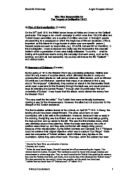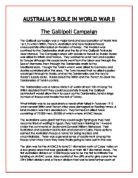As a result of the troops’ random placement around the shoreline, the Turks were able to cut down large numbers within minutes. By mid-morning, the whole force was confronted with increased numbers of Turkish soldiers. This was due to a huge amount of misfortune for the allies, as it was on that morning that the Turkish commander had intended to take his troops for an exercise near Hill 971. After the landings, he redistributed his troops for counterattack. In the afternoon and evening, the left position was attacked and the line was driven back to form two positions, “Baby 700” and “the Nek” several miles from where they were believed to be. These misfortunes could be due to British bad planning. The reason for this is because it can be seen as the Allies underestimating the Turkish troops. They were not expecting the Turks to put up this big a fight. Therefore, yet more blame can be placed upon the allies, as a result of their underestimating, and to a certain extent their arrogance.
By the evening, the commanding officers had an extremely vague idea of where the troops were. As a result of the Turkish attacks, hundreds of men had been separated from their regiment, and had begun to descend to the beach. Under these conditions, General Bridges recommended evacuation. Birdwood agreed. However, the man in charge of the operation, under naval advice that an evacuation would be almost impossible to organise, overruled his commanders, and commanded that the troops “dug in”. The first day of landings cost the Anzacs around 2000 killed and wounded. Much of this can be labelled as bad planning, and an extreme amount of bad luck for the allies.
C) Evaluation of Sources (4 marks)
Two of the sources I used were:
Peter Weir’s Film: “Gallipoli”, released in 1981 by Australian Film Distribution Company.
This movie is obviously an Australian point of view, and as a result is biased, which is definitely a limitation. However, it gives a clear indication of how the troops landed, and just how bad communications were in the trenches. Its main purpose is to show the rest of the world what the Australians went through at the front. The scenes, from which I retrieved most of my information from, were the last few. This is when the troops are awaiting the push. The reason for this, is because it shows how the English were not really that involved in the campaign, but were in fact in a tent, a couple of miles away from the trenches. In this film, it is the British officers that are seen as responsible for the tragedy.
Alan Sutton Publishing, 1989. “DAMN THE DARDANELLES! The agony of GALLIPOLI”. United Kingdom. John Laffin
This book proved to be a fantastic read, and had lots of useful information on Gallipoli. John Laffin was an Australian historian, with expertise in 20th Century forces. He spent most of his life researching the First World War, and looking at various perspectives on controversial battles, such as Gallipoli. Its main limitations however, are that it is an Australian writing, who therefore saw everything from an Australian point of view.
Both of theses sources were written after the event happened, and so, are not necessarily accurate. Also, with the film, many people generally see a film, and believe that is exactly the way that particular event took place. This can be seen as a positive or a negative thing. The book was a very useful source, as it provided in depth analysis of the events, which took place, whereas the film is limited to a certain amount of time etc, and therefore, could not include all the necessary details.
D) Analysis
Generally, the tragedy at Gallipoli is looked at through the eyes of ordinary soldiers, scholars, military historians, naval historians, journalists, politicians and senior Service officers. Perhaps the most interesting to look at, is that of the men that lived through the experience as ordinary soldiers. One soldier’s diary read: “Perhaps as the years roll by, we will be remembered as the expedition that was betrayed by jealousy, spite, indecision and treachery. The Turks did not beat us – we were beaten by our own High Command”. This source clearly shows that some of the soldiers believed that they were being killed as a result of the Generals that were commanding the expedition in tents on the beach, several miles away.
Many historians, politicians and journalists tend to place the blame on the British, and their poor organization. Historian’s R. Ernest Dupuy and Trevor N. Dupuy said; “With the exception of the Crimean War, the Gallipoli Expedition was the most poorly mounted and ineptly controlled operation in British military history.”
In my opinion, much of the blame should be placed upon the British commanders. The reason for this, is because they rushed into a confrontation, without researching nearly enough of the soldiers they would be fighting, or organizing their attacks well enough.
For example, it is widely believed that Braithwaite is responsible for the separation of the General Staff and the Lines-of-Communication (or Administrative) staff. He believed that the administrators were not real soldiers, but instead were businessmen. However, despite this, the administrative staff were left completely out of discussions. When the GHQ transferred from the Arcadian to the Queen Elizabeth, the chiefs of administration were left behind, and were even deprived of using the “wireless telegraph”! Braithwaite was required to join the GHQ and Lines-of-Communication HQ together. He failed.
Further blame can be placed on Winston Churchill. He had a brilliant scheme, which was to capture Constantinople. This idea was possible, and desirable to Churchill, and as a result, he leapt to the conclusion that successful accomplishment must follow. As a result, he rushed into a confrontation, without considering what forces were necessary to win, and he did not look at the consequences of failure. Many critics have criticized his “strategy”. With Gallipoli, he had no real strategy, and his knowledge of tactics was virtually non-existent.
Poor organization of the British can also be seen as a cause of the stalemate in Gallipoli, as it seemed the British rushed headlong into a confrontation without looking at anything like tactics or strategies. The belief that a victory was obtainable within hardly any time, proved to be a dire miscalculation.
However, although much of the blame lies in the hands of the British, the New Zealand, Australian and French commanders must also share this responsibility. They also did not organize their attacks or their strategies, and as a result, lost many men in unnecessary attacks.
E) Conclusion (2 Marks)
In conclusion, the British must take most of the responsibility for the tragedy at Gallipoli, as it was Churchill that wanted to gain territory in Constantinople that caused the attack in the first place! As a result, the British war cabinet quickly formulated, a plan to defeat the Turkish troops in Gallipoli and the Dardanelles. As the evidence shows, these plans of attack were poorly organized, and badly carried out. The communication between the GHQ and the trenches was severely inadequate, leading to spur of the moment decisions, which proved, (more often then not), to be the wrong thing to do.
From the British especially, Winston Churchill and General Sir Ian Hamilton must be held guilty for this loss of life, as it was they that commanded the entire attack. However, some of the blame must be placed upon the Australian, New Zealand and French officers, as it was they who commanded various failed attacks.
Eventually, the British released that victory was not possible, and as a result, the order was given to withdraw all troops residing in the Dardanelles Straight and Gallipoli. However, I am convinced that with better organization and better planning, the British could easily have gained victory over the Turks in the battle at Gallipoli, 1915.
F) List of Sources (2 Marks)
Dupuy, R. Ernest and Trevor N. 1970. “The Encyclopedia of Military History”. London. Oxford Printing ltd.
Haythorntwaite, Philip J. 1991. “GALLIPOLI 1915. Frontal Assault on Turkey”. London. Osprey Publishing ltd.
Hickey, Michael. 1995. “Gallipoli”. London. John Murray Publishers ltd.
Laffin, John. 1980. “DAMN THE DARDANELLES! The Agony of GALLIPOLI”. Gloucester. Alan Sutton Publishing.
Weir, Peter 1981. “Gallipoli” Australia. Australian Film Distributing Company.
WORD COUNT: 1,824
Directed by Peter Weir, see evaluation of sources
Before the naval attack began, Churchill consulted the officer commanding the Aegean, Vice Admiral Sackville Carden. He stated “The Dardanelles could be forced with enough warships and minesweepers in a three stage plan. First, we would neutralise the Turkish forts guarding the entrance, then clear the Turkish minefields, and finally, drive into the Sea of the Maramara the Turkish troops.” This plan persuaded the war council victory was possible, and the attack was formulated.
Attacks from sea lasted from 19th February until 13th March 1915.
Australian and New Zealand Army Corps. Although these were the majority of soldiers, the campaign also involved men from Britain and Ireland. A more minor role was played by the Indian and French soldiers.
This was the result of the Ottoman Empire being known as the “Sick man of Europe”.
The commander of the First Division. The first Australian to be promoted to major general, and the first to command a division.
A commanding officer that landed that afternoon.
Source: DAMN THE DARDANELES! The Agony at GALLIPOLI. John Laffin
Source: The Encyclopedia of Military History. R. Ernest Dupuy and Trevor N. Dupuy
Major-General W. P. Braithwaite was Hamilton’s Chief-of Staff.
The Administrators controlled areas such as supply, shipping, water, hospital services etc.
Strangely enough, this was not far from the truth. It was thought that war was far to complex a business to leave in the hands of the fighting generals!
Both were battleships, from where the battle was commanded. Hamilton in fact, controlled the entire operation from a ship, and never once stepped ashore!







